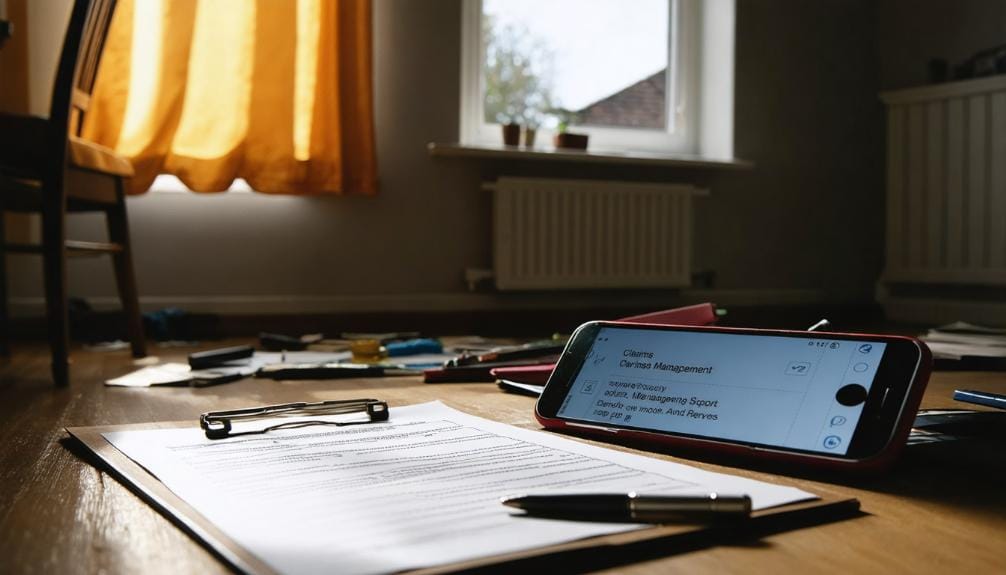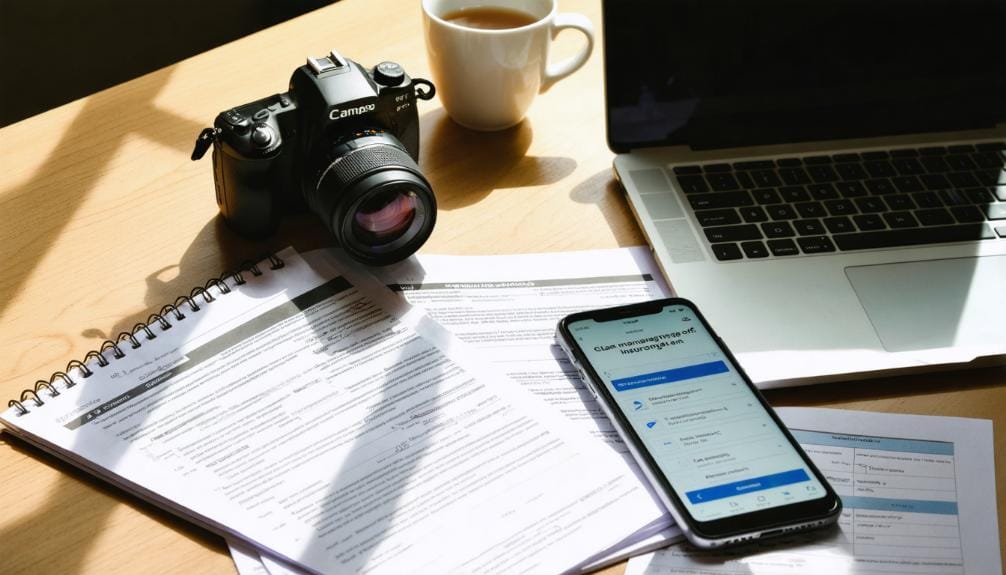Discovering your home has been burgled is a traumatic experience. Knowing the right steps to take immediately is crucial for your safety, the police investigation, and for a successful insurance claim.
This article outlines the essential actions you should take in the immediate aftermath of a burglary in your home in the UK, with expert guidance from PCLA, your local claims management service.
After a burglary, call 999 if the crime is in progress or has just occurred. Move to a safe location and await the arrival of the police. Once you are secure, document the scene by taking photographs of any damage and missing items while avoiding areas that may contain potential fingerprints. Contact your bank to freeze your accounts and cancel your cards. File a police report within 24 hours and notify your insurance company with the crime reference number. Taking the right steps now will help protect your interests later.
Key Takeaways
- Call 999 immediately if a burglary is in progress, or contact your local police to report the incident and obtain a crime reference number.
- Avoid touching anything at the scene to preserve potential evidence, and take photographs of any damage and missing items.
- Contact your insurance provider within 24 hours, providing them with the crime reference number and detailed documentation of the stolen items.
- Cancel all stolen bank cards, change passwords on any compromised accounts, and activate fraud alerts with your financial services.
- Create a comprehensive list of the stolen items, including serial numbers, photographs, and proof of purchase, for both the police and your insurance claims.
Emergency Response and Safety Measures

When burglars strike, every second counts in ensuring personal safety. The first priority is to call 999 if the break-in is occurring or has just happened. Move to your designated safe room if possible and avoid any confrontation with intruders.
Having emergency contacts readily available and practising safety drills with family members can make a significant difference. Remember to provide clear details to emergency services about the situation – including descriptions of any intruders you may have seen.
Stay in your secure location until the police confirm it is safe to come out. If evacuation is possible without encountering intruders, exit the house quickly and quietly through your pre-planned escape routes. Always gather at your family’s pre-designated meeting spot outside the home when evacuating.
Regular practice of these procedures helps ensure everyone knows exactly what to do when seconds matter most.
Related: Find out what theft and burglary home insurance claims include and when to contact a loss assessor.
Securing Your Property and Gathering Evidence
Securing your home immediately after a burglary requires a delicate balance between preserving evidence and protecting your property. Evidence preservation starts with avoiding contact with potential fingerprint locations while conducting a thorough assessment of the damage and missing items. Call the police immediately if you discover signs of a break-in to ensure proper investigation.
| Evidence Type | Documentation Method | Priority Level |
|---|---|---|
| Physical Items | Photos & Collection | Immediate |
| Missing Objects | Detailed List | High |
| Entry Points | Photos & Security | Urgent |
Document everything meticulously with photographs and detailed notes. This includes capturing images of entry points, damaged areas, and spaces from which items were taken. Remember to check CCTV footage if available and encourage the police to interview neighbours who might have witnessed any suspicious activity.
Create a comprehensive list of stolen items with serial numbers and descriptions – this will be essential for both the police investigation and insurance claims.
Filing Your Police Report and Insurance Claim

The immediate aftermath of a burglary requires communication with both law enforcement and insurance providers.
If security cameras are present, police will need to review CCTV footage to help identify potential suspects and gather evidence of the crime.
Effective police cooperation begins by preserving the crime scene and avoiding contact with surfaces where evidence might be present. When officers arrive, guide them to potential evidence and security footage while providing detailed information about the incident.
Insurance communication should happen within 24 hours of filing the police report. Document all damaged or stolen items through photographs and create a thorough list. Have your crime reference number ready when contacting your insurance provider.
Keep copies of all receipts and documentation to support your claim.
Remember to maintain detailed records of all interactions with both the police and insurers. This documentation proves essential for tracking the progress of your case and ensuring a smooth claims process.
If you’re unsure what your insurance policy covers in cases of theft or burglary, this article explains the key points.
Protecting Your Financial and Digital Assets
After a burglary, your first move should be to contact your bank to cancel any stolen cards and secure your accounts before thieves can exploit them.
Taking stock of missing digital devices such as phones, laptops, or storage drives will assist you in notifying the relevant providers and changing passwords for any accounts that may have been compromised.
Regularly monitoring your financial statements in the following weeks can help identify any suspicious activity that could indicate identity theft or fraud.
Make sure to document missing items with detailed descriptions and any available photos to assist with insurance claims and police investigations.
Cancel Cards Immediately
When burglars strike your home, protecting your financial assets becomes a critical priority. Victims should immediately contact their banks and credit card companies to report stolen cards. Swift action with card cancellation and fraud prevention can protect against unauthorised transactions.
Most financial institutions respond quickly to theft reports. They’ll cancel compromised cards and issue new ones without delay. Remember to document all communications with your bank for future reference. Having your crime reference number ready when contacting financial institutions will help expedite the process.
Time matters in these situations. Reporting stolen cards within 24 hours increases the chance of recovering funds from unauthorised purchases.
Don’t forget about digital devices either – if phones or tablets containing financial information are taken, notify service providers immediately.
Contact your bank’s fraud department directly. They have experience handling these situations and will guide you through securing your accounts.
Monitor Account Activity
Cancelling compromised cards sets vital protection in motion, but monitoring account activity provides ongoing defence against financial threats.
Setting up account alerts guarantees immediate notification of any suspicious transactions. Regular transaction monitoring becomes important in the weeks following a burglary.
Most banks offer strong fraud protection and will reimburse unauthorised charges when reported promptly. Bank fraud teams can assist with reviewing suspicious activity after receiving your police report number.
Want extra peace of mind? Consider enabling two-factor authentication for all financial accounts. This simple step adds a powerful layer of security.
Keep a watchful eye on both recent and pending transactions. Thieves sometimes test accounts with small purchases before attempting larger fraud.
Keep in mind that vigilance pays off – catching unauthorised activity early can prevent significant financial losses and simplify the recovery process.
Update Digital Security
Digital security requires immediate attention following a break-in. If devices were stolen, thieves may attempt to access personal accounts and sensitive information. Taking swift action can prevent further losses and protect digital assets.
Start by implementing strong password management across all accounts. Change passwords immediately, especially for banking and email services. Use complex combinations and avoid any personal information that thieves might have gathered from stolen documents. Using three random words can create memorable yet secure passwords as recommended by cybersecurity experts.
Fortify your home network encryption to prevent unauthorised access. Update your router settings and enable WPA3 security if available. Check all connected devices for suspicious activity and remove any unknown connections.
Consider enabling two-factor authentication on critical accounts and installing updated anti-virus software on remaining devices.
Remember to activate tracking features on any new replacement devices to enhance security moving forward.
Essential Documentation and Record-Keeping

Immediately after a burglary, taking clear photographs of damaged property and the locations of missing items creates essential documentation for both police reports and insurance claims.
A digital record of serial numbers for electronics, appliances, and significant items proves indispensable when filing reports and tracking recovered property.
Smart organisation of this evidence through cloud storage guarantees that these critical details remain accessible even if physical documents are compromised during the break-in.
Getting a crime reference number from the police when filing your report is crucial for proceeding with insurance claims and tracking the investigation’s progress.
Once you’re ready, this guide on filing a burglary or theft insurance claim walks you through the process step by step.
Photographing Evidence and Damage
Proper documentation through photography serves as an important first step after a home burglary is discovered. Effective photographic techniques ensure vital evidence preservation for both police investigations and insurance claims. Taking clear, well-lit photos immediately helps document the scene before anything is disturbed. Scene preservation must be carefully maintained while photographing to protect valuable forensic evidence.
| Area to Photograph | What to Capture | Why It Matters |
|---|---|---|
| Entry Points | Broken locks/windows | Demonstrates forced entry |
| Interior Damage | Ransacked rooms | Records the extent of damage |
| Missing Items | Empty spaces | Provides proof of prior presence |
| External Evidence | Footprints/marks | Assists investigation |
Remember to photograph from multiple angles and include close-ups of any damage. Digital storage ensures that photos remain safe and accessible when needed for claims processing or police follow-up. Keep backup copies in a secure location separate from your primary residence.
Note: Take time to understand why some theft claims get rejected so you can avoid common pitfalls.
Tracking Serial Numbers Digitally
Serial numbers serve as essential lifelines when recovering stolen property after a burglary. Modern digital tracking platforms like Immobilise make it easier than ever to record and manage these vital identifiers. By maintaining digital records of your possessions’ serial numbers, you’re taking a proactive step towards potential recovery.
Many homeowners wonder about the best way to store this information. The answer lies in secure digital platforms that offer multiple backup options. These systems allow quick access when filing police reports and insurance claims. They also enable law enforcement to swiftly cross-reference stolen items against national databases. Digital tracking systems provide high visibility tracking throughout the entire recovery process.
Remember to photograph each item alongside its serial number and store the images in cloud-based storage. This creates an additional layer of documentation that proves ownership and helps reunite you with your belongings.
Building a Stronger Home Security Strategy
A thorough home security strategy can mean the difference between a secure home and an easy target for burglars. Modern home automation systems paired with traditional security upgrades create a robust defence against intruders.
Start by reinforcing entry points with high-quality deadbolts and window locks. Consider adding security film to windows and installing hinge bolts on external doors. Smart doorbells and CCTV cameras provide real-time monitoring capabilities. PAS24 certified doors offer superior protection against forced entry attempts.
Outdoor lighting with motion sensors helps eliminate hiding spots, while maintaining well-trimmed landscaping reduces vulnerabilities.
Don’t forget to secure tools and ladders that could assist break-ins. Working with neighbours through community watch programmes adds another layer of protection.
Remember to regularly update security codes and keep important item records current.
Immediate Help After a Burglary
Taking the right steps after a burglary is vital for your safety, the police investigation, and the success of your insurance claim. If your home has been burglarised, every second counts. Record the scene with clear photographs and videos, and make sure to contact the police and your insurer within 24 hours.
PCLA, based in Northern Ireland, understands the emotional distress and urgency of the situation and is here to provide immediate support and expert claims management.
We’ll help you organise all your documentation and manage the discussions with your insurer. Let our experienced claims management team support you through every step of the process.
Contact us today for a free, no-obligation survey. We’ll assess the damage, guide you through the claims process, and ensure you receive the settlement you deserve.
Let PCLA help you recover from this difficult experience. No win, no fee.



